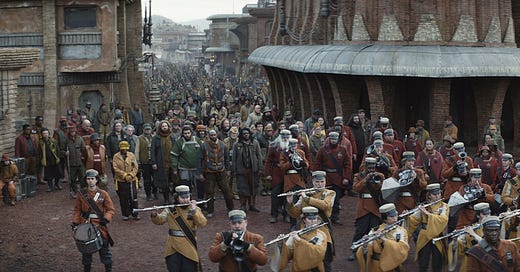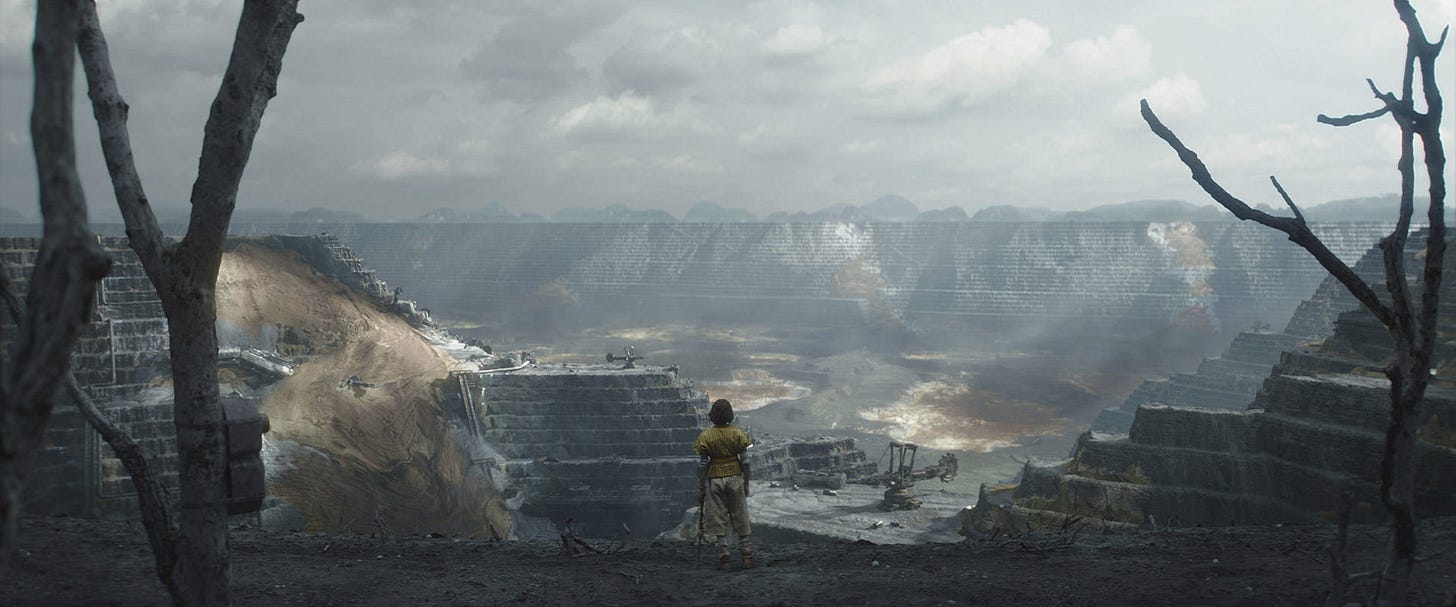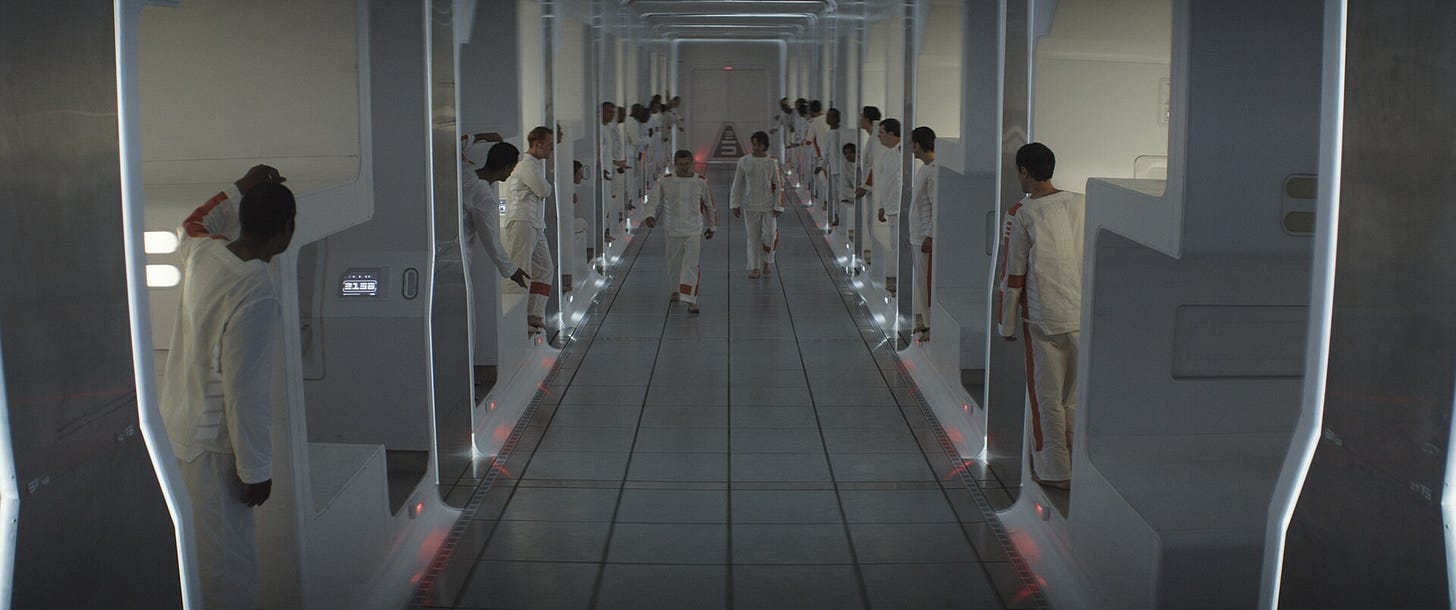Star Wars show Andor is the story about resistance we need right now
Why science fiction matters for social change
Andor Season Two came out this week. If you care about stories of resistance, you should be watching. Last week, I explored Subaltern Studies in social change communication: this week, I want to show how Andor brings those ideas to life in the most unexpected of places: Star Wars.
Why Andor is great subaltern storytelling (yes, really)
Spoiler alert for season one!
I’m hooked on Andor. You know that feeling where you can’t watch anything else because it doesn’t come close? This is what I have for Andor right now.
What I love is the way Andor brings together great storytelling, empathy for a big cast of diverse characters along with a strong social change sensibility.
Why This Matters: Sci-fi narratives
Stories shape our political imagination.
Science fiction is a genre where we see narrative at work because people are trying to create something new, and so we can see what ideas and stories they draw on, subconsciously or otherwise. When you tell a story of a made-up or future world, you have to decide what aspects of humanity to draw on and enlarge, and which ones to ignore.
That is why it is so wonderful to see Andor, like Black Panther before, draw on a wider palette of human experience for its storytelling, from The Battle of Algiers to Trotsky.
If all our sci-fi is dystopian cyberpunk like Blade Runner or predicts climate disaster like Waterworld, this will start to warp our understanding of politics and society, and limit our expectations of what futures are possible.
I have this untested hunch that Star Trek fans are more likely to be progressive because they immerse themselves in a world/universe where humanity are united. We need to see these visions of possible futures in order to grow a shared humanity worldview and start changing how we think issues like about migration and nature.
Science fiction tells us a story about where we are headed that influences what we believe is possible. This influences how we act. And in the dark times we face today, we need every inspiration possible to maintain solidarity, community and trust in our fellow human beings.
This is why we need more SolarPunk storytelling. It’s not just about imagining a world where humans live in harmony with nature, and with each other, but about new ways of telling the story of how we respond to the challenges that are always going to be part of life.
How Andor addresses social change themes
Andor abandons the old hero’s journey trope for a multiplicity of intertwining character and story arcs. The show is named for Cassian Andor, a future rebel leader—but he is not the only one driving the story.
The show is really about how people respond to creeping imperialism and oppression.
The protagonist, Cassian Andor, comes from an indigenous community devastated by mining. He spends the first three episodes getting in scrapes with privatised corporate security forces. In most of Star Wars, the Empire are just evil villains. Here imperialism is clearly linked to extractive capitalism in all its evil banality.
Early in the season we see a heist that made me think of the 1930 Chittagong Uprising led by Indian Independence fighters. Then it moves to a terrifying ultra-modern gulag for which the makers drew on the USA’s prison-industrial complex.
Here it asks where people can find a chink of hope to spark resistance when they find themselves forgotten in the darkest holes in history. Personally it made me think of Vasily Grossman’s account of the Treblinka Uprising.
Finally, it ends on an incredible crescendo, with a funeral march that seems to meld the cultures of northern English trade unions and the Zapatistas or other indigenous Latin American communities. Then Cassian Andor’s late mother delivers a rousing call to action in a posthumous eulogy she delivers by hologram (trust me, it works):
“The Empire is a disease that thrives in darkness, it is never more alive than when we sleep. It's easy for the dead to tell you to fight, and maybe it's true, maybe fighting is useless. Perhaps it's too late. But I'll tell you this, if I could do it again, I'd wake up early and be fighting those bastards from the start!”
Resistance comes from below
Most of Star Wars is essentially a family drama about the Skywalker clan: heroes predestined for greatness. Andor is an origin story for the Rebellion that is about the everyday people who make up the resistance.
Andor doesn’t just give us a working-class hero: it gives us a working-class planet of scrap metal workers.
The story of how change happens in Andor is that people need to unite and work together, rather than waiting for an elite space monk to come and rescue us.
Community as the site of resistance
Community is an important theme in subaltern writing, especially the work of Partha Chatterjee, who shows how subaltern action is driven from their own political consciousness, not one shaped by elites (and, in the case of India, is often framed in religious terms).
You can see how resistance grows out of community in Andor. These are characters who would rather not fight. They just want to live. Even when they face repression, their instinct is to run and hide rather than confront injustice. It is love and care for each other that eventually drives them to act.
Everyday Defiance
Andor celebrates the small, everyday acts of defiance of everyday people: the intermediary who keeps a secret two-way radio in their workshop, the boy radicalised by his father’s unjust arrest, the fisherfolk who help a prisoner escape.
In The Power of the Powerless, Vaclav Havel described the role of social proof in maintaining authoritarianism. When the shopkeeper puts the regime’s propaganda in their window, it sends a message that everyone supports the regime, and if you feel otherwise, you are alone. When they choose not to put up that poster, it tells you that you are not the only one who opposes the regime.
Moral Complexity - “I share my dreams with ghosts”
Within the working-class community we see a complex array of characters and decisions: those who give everything to resistance, those who settle for small acts of defiance, those who choose just to get by, and those who collaborate.
And the resistance themselves are not angels. They have to make hard moral choices. The shady leader of the resistance makes this clear in a powerful monologue:
“I’m condemned to use the tools of my enemy to defeat them. I burn my decency for someone else’s future. I burn my life to make a sunrise that I know I’ll never see.”
People often think thinking about the future with hope is about imagining a perfect world. Andor shows that it is actually about imagining how we can get better and working together to face the challenges the future will bring: with more care, community and compassion.
What stories have resonated with you while also being fun to watch?
Hopey, changey stuff
Hope-based expert Mika Ortega talks about the victim to human shift in this deeply moving episode of the Journalists for Human Rights (JHR) podcast.
We got great feedback when we reposted Monica’s article The Narrative Antidote to Authoritarianism last month, so check out the follow-up piece on expanding Circles of Identity, Care, and Solidarity. There is too much good stuff in this article to summarise so read it to the end. And let us know what other kind of guest posts you’d like more of in future in the comments!
The scientific case for pausing via Michael Braithwaite on LinkedIn.
Also released this week, a new Spanish series about the environment called Hope! They also have a wonderful Instagram feed.
“We have definitely awakened something, some kind of hope, that there could be a change—because it has come from the bottom, from the students and from the young people” - Rewire Democracy speak to people involved in the massive student protest movement in Serbia.
“If we truly believe that feminism can win, then it means that misogyny is not inherent, instead it our children are socialised into it” - Mumbi Kanyogo from Well Made Strategy on Netflix show Adolescence, which has really started a conversation on radicalisation of boys and young men.
Brain Science Corner
Nice clip summarising the key brain science behind the hope-based approach from the Friedrich Naumann Foundation. Thanks to Boryana Atanassova for making this happen.
Quote of the week
The urge I feel is
to give things names but
Everything is already
Named
Jason Allen-Paisant - from the poem ‘Naming’ from his collection ‘Thinking with Trees’.









I think all of us who have worked for social change know a Luthen character, whose sense of duty to the cause is both ennobling and a deeply flawed story of justified self-sacrifice. He's such a brilliantly drawn character among so many brilliantly drawn characters, and I see in him so many NGO leaders I've worked with.
Love this. Great analysis. And fascinating to read a totally different (albeit overlapping) take to my own!
I was watching this incredible walkthrough of "Why Andor feels so real" (https://www.youtube.com/watch?v=UhgXXhcPQEM), which looks at the ways that the actual filmmaking and directing differ from other Star Wars movies and series. And the ways that helps us enter the story world.
For instance, by starting from the zoomed in textures and environments of the sets and character experiences before zooming out to the wider world, rather than starting with a big CGI set piece before zooming in and trying to convince us we're there, and the ways that the former approach helps everything feel tangible and truthful. And engages us in a different way.
Obviously, I instantly saw the parallels to climate communication.
More often than not, climate messages still start from these lofty, intangibles: Act now. End climate change. Earth is dying. Save the polar bears, etcetera. Abstract messages responding to a problem framed in an abstract manner. I see this as the direct equivalent to the old Star Wars approach: The big wide CGI shot.
Of course, the work to help people take notice and take action then begins and guess what? It's really hard. Because of issues like psychological distance, a total lack of feelings of relevance, no sense of agency or being able to affect anything. The disassociated surreality of it all.
Not only do we need to move the focus of the storytelling to the grassroots, as you point out, and put the power in the people and the communities and the possibilities, we need to move the message-making and frame-setting there too. To close down the psychological distance and help folks see, smell, feel their roles in all this. And the power they have, all of them, to do something about it.